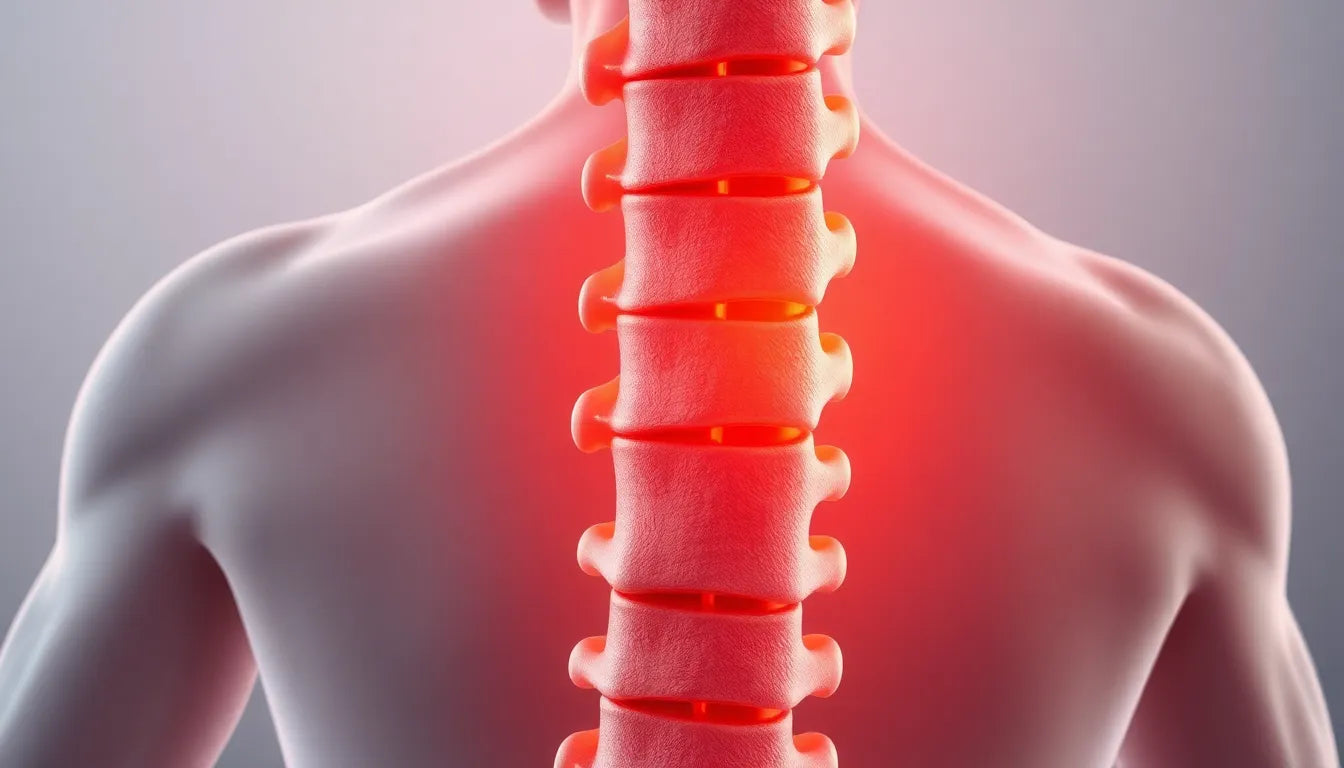A herniated disc in the lower back is a common condition that, despite its prevalence, often goes unnoticed until it significantly disrupts daily life. Many individuals may experience subtle signs without understanding the underlying cause, leading to prolonged discomfort and potential complications. Lower back issues are widespread, and while some may dismiss occasional pain as a normal part of life, it's crucial to recognize when these symptoms might indicate something more serious.
Understanding a herniated disc in the lumbar region
A herniated disc occurs when the soft inner core of a spinal disc pushes through a crack in the tougher outer layer. This condition is particularly common in the lumbar region, or lower back, due to the significant stress and movement this area endures. The lumbar discs act as shock absorbers between the vertebrae, and when they herniate, they can press on nearby nerves, causing a range of symptoms.
Early recognition of these symptoms is vital for preventing further damage and improving one's quality of life. The sooner a herniated disc is identified, the more effectively it can be managed, reducing the risk of chronic pain and mobility issues.
Objective of this post
The purpose of this post is to equip readers with the knowledge to identify the subtle symptoms of a herniated disc in the lower back. By understanding these signals, individuals can seek timely medical intervention and adopt appropriate management strategies. Identifying these signs early can lead to more effective treatment and a quicker return to normal activities, ultimately enhancing one's overall well-being.
Primary symptoms of a herniated disc in the lower back
Recognizing the primary symptoms of a herniated disc in the lower back is crucial for timely intervention. These symptoms can vary in intensity and impact, but they often share common characteristics that can help in early identification.
Lower back pain
Lower back pain is often the first and most noticeable symptom of a herniated disc. This pain can be either intermittent or continuous, and it typically worsens with certain movements, coughing, or sneezing. The pain may be described as burning, stinging, or sharp, depending on the individual's experience. Here's a quick comparison of pain characteristics:
| Pain Characteristic | Description | Common Triggers |
|---|---|---|
| Burning | Intense, fiery sensation | Movement, bending |
| Stinging | Sharp, piercing pain | Coughing, sneezing |
| Sharp | Sudden, acute pain | Lifting, twisting |
Sciatica
Sciatica is another common symptom associated with a herniated disc in the lower back. It manifests as a sharp, shooting pain that extends from the buttock down the leg, often reaching the calf or foot. This pain results from pressure on the spinal nerve and can significantly impact mobility. The diagram below illustrates the nerve pathways and pain distribution:

Numbness or tingling
Numbness or tingling is a symptom that typically affects the leg and/or foot, depending on which nerve root is compromised. Common areas where numbness occurs include:
- Buttock
- Thigh
- Calf
- Foot
- Toes
Muscle weakness
Muscle weakness is a significant symptom that can affect the legs and/or feet, leading to difficulties in walking or performing certain movements. This weakness may also be accompanied by decreased reflexes, particularly at the knee or ankle, which can further impair mobility and balance.
Additional information on herniated disc symptoms
Specific nerve root impacts
The symptoms of a herniated disc can vary depending on which nerve root is affected. For instance, different nerve roots such as L4, L5, and S1 are associated with distinct symptom patterns. The chart below provides a detailed mapping of symptoms to specific nerve roots:
| Nerve Root | Common Symptoms |
|---|---|
| L4 | Pain in the thigh, weakness in the quadriceps, decreased knee reflex |
| L5 | Pain along the side of the leg, weakness in the foot and big toe |
| S1 | Pain in the calf, weakness in the ankle, decreased ankle reflex |
Warning signs requiring immediate attention
While most symptoms of a herniated disc can be managed with medical intervention, certain warning signs demand immediate medical attention. These include loss of bladder or bowel control, which could indicate a serious condition known as cauda equina syndrome.
Diagnostic approaches
To accurately diagnose a herniated disc, healthcare providers often rely on physical examinations and specific tests like the straight leg raise test. These diagnostic tools help determine the extent of nerve involvement and guide appropriate treatment plans.
Understanding these symptoms and their implications is essential for managing a herniated disc effectively. By recognizing the signs early, individuals can seek medical advice and explore treatment options that can alleviate discomfort and enhance their quality of life.
Patient experiences and management of herniated discs
While clinical information provides a foundation for understanding herniated discs, patient experiences offer invaluable insights into the day-to-day challenges and management of this condition. Many individuals with herniated discs share stories of how subtle symptoms initially went unnoticed, only to escalate into more severe discomfort. These narratives highlight the importance of early symptom recognition and proactive management strategies.
One common theme in patient experiences is the impact of lifestyle changes and ergonomic adjustments. Simple modifications, such as incorporating ergonomic furniture and practicing proper posture, can significantly alleviate symptoms and prevent further injury. Anodyne's ergonomic solutions, for example, are designed to support the spine and reduce strain, making them a valuable component of comprehensive symptom management.
Treatment and prevention strategies
Effective management of a herniated disc in the lower back often involves a combination of treatment options and preventive measures. Physical therapy is a cornerstone of treatment, focusing on strengthening the muscles supporting the spine and improving flexibility. In some cases, medications such as anti-inflammatories or muscle relaxants may be prescribed to manage pain and discomfort.
Preventive strategies are equally important in managing a herniated disc. Regular exercise, maintaining a healthy weight, and avoiding activities that place excessive strain on the back can help prevent future herniations. Additionally, ergonomic aids, like those offered by Anodyne, can support proper spinal alignment and reduce the risk of exacerbating symptoms.
When to seek medical care
Recognizing when to seek medical care is crucial for individuals experiencing symptoms of a herniated disc. While many cases can be managed with conservative treatments, certain red flag symptoms require immediate attention. These include severe or worsening pain, significant muscle weakness, or loss of bladder or bowel control, which may indicate a more serious condition such as cauda equina syndrome. Prompt medical evaluation is essential to prevent long-term complications.
Frequently Asked Questions
What are the first signs of a herniated disc in the lower back?
The first signs of a herniated disc in the lower back often include localized pain that may be intermittent or continuous, and it typically worsens with movement, coughing, or sneezing. Other early symptoms can include numbness, tingling, or weakness in the legs or feet.
How is a herniated disc diagnosed?
A herniated disc is typically diagnosed through a combination of physical examinations and imaging tests. Healthcare providers may use the straight leg raise test to assess nerve involvement and may recommend an MRI or CT scan to confirm the diagnosis and evaluate the extent of the herniation.
Can a herniated disc heal on its own?
In many cases, a herniated disc can improve with time and conservative treatment. The body may gradually absorb the herniated material, reducing pressure on the nerves and alleviating symptoms. However, recovery can vary depending on the severity of the herniation and individual factors.
What are the recommended treatments for a herniated disc?
Treatment options for a herniated disc include physical therapy, medications to manage pain and inflammation, and lifestyle modifications. In some cases, epidural steroid injections or surgical intervention may be necessary if conservative treatments are ineffective.
How can lifestyle changes help manage symptoms?
Lifestyle changes play a crucial role in managing herniated disc symptoms. Regular exercise, weight management, and ergonomic adjustments can help reduce strain on the spine and alleviate discomfort. Additionally, practicing good posture and avoiding activities that exacerbate symptoms can prevent further injury.
Sources
- Mayo Clinic Staff. "Herniated Disk." Mayo Clinic.
- Cleveland Clinic. "Herniated Disk: Symptoms, Causes, and Treatments." Cleveland Clinic.
- Penn Medicine. "Herniated Disc." Penn Medicine.
- Johns Hopkins Medicine. "Herniated Disk." Johns Hopkins Medicine.
- Spine-health. "Lumbar Herniated Disc Symptoms." Spine-health.
- Physio-pedia. "Herniated Disc." Physio-pedia.
- OrthoInfo/AAOS. "Herniated Disk in the Lower Back." OrthoInfo.



